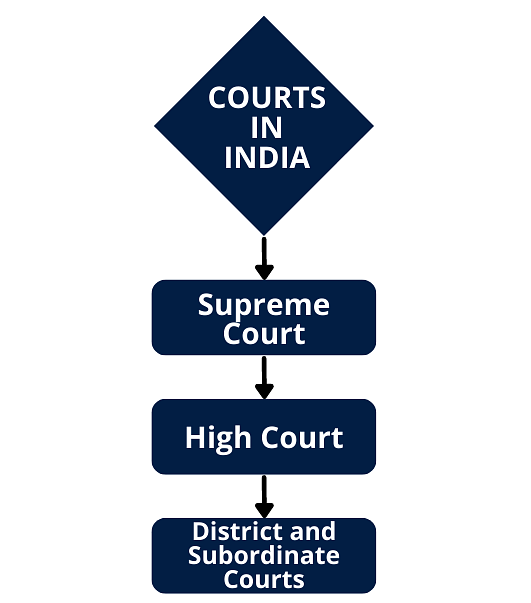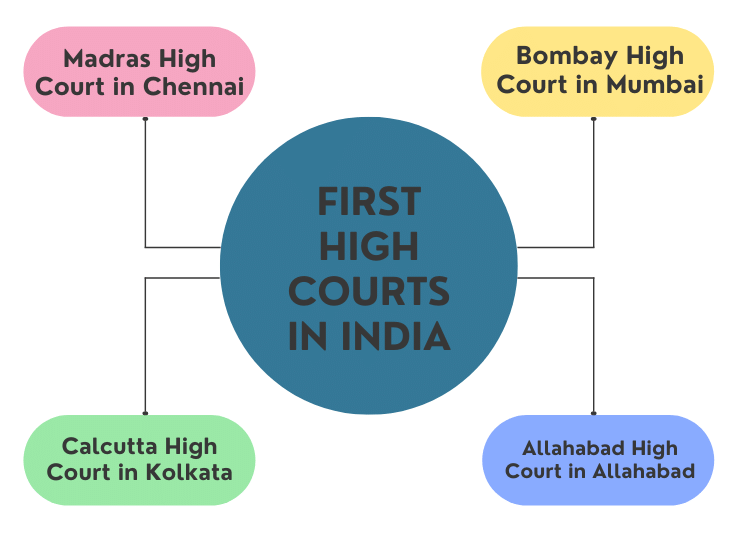Humanities/Arts Exam > Humanities/Arts Notes > Chapter Notes: Structure & Hierarchy of Courts in India
Structure & Hierarchy of Courts in India Chapter Notes - Humanities/Arts PDF Download
The federal system of governance that India has established divides the power to make laws between the Center and the States. However, the Constitution creates a single, integrated system of justice that includes courts to carry out both Central and State legislation.

- India's highest court is the Supreme Court, which is located in New Delhi.
- At the state level, it is followed by a variety of High Courts that serve one or more states.
- The district and subordinate courts, which are referred to as the lower courts in India, come after the High Courts.
1. Supreme Court of India
- The Supreme Court of India came into being on 28 January 1950.
- It took the place of the Federal Court of India and the Judicial Committee of the Privy Council.
- The Indian Constitution called for a Supreme Court with a Chief Justice and seven other judges.
- The Parliament had the authority to expand the number of judges.
- There are now 31 judges on the Supreme Court, including the Chief Justice of India.
2. High Courts
- India has 24 High Courts that oversee the states and union territories.
- A state, a union territory, or a collection of states and union territories are subject to the jurisdiction of each High Court.

3. District and Sub-ordinate Courts
- The term "lower Courts" refers to the courts that work beneath the High Courts. They are made up of district and subordinate courts.
- A "District and Sessions Judge" presides over the judicial districts that are established within each state.
- When presiding over a civil matter, the judge is referred to as a "District Judge," and when presiding over a criminal case, he is referred to as a "Sessions Judge."
- In addition to the subordinate Courts, the Munsiff Courts are included in this hierarchy.
A group of judges sitting together on a legal matter in the Court constitutes a bench.
The lawyers constitute the members at the bar.
A division bench comprises of two or three judges.
A constitutional bench comprises of five or more judges and may even extend to thirteen judges.
4. Tribunals
- Indian judiciary is also characterised by numerous semi-judicial bodies involved in dispute resolution.
- These bodies carry out semi- or quasi-judicial functions.
- Their creation aims to improve dispute resolution effectiveness and reduce the burden on courts.
- These tribunals work with regulators in some cases. Regulators are specialised governmental agencies that keep an eye on how well the relevant government sectors uphold the law and the rule of law.
Salient Features of Indian Judiciary
1. India as a Common Law Jurisdiction-
- Under the scheme of the common law system, the decisions, orders and judgments developed by the judges in India help in the creation and development of laws and legal principles, which becomes binding precedents for all subordinate courts in the hierarchy.
- Therefore, courts play a vital role in creating laws, especially where gaps in law exist, and the legislature or executive have failed to enact laws.
2. Adversarial Model of Dispute Resolution-
- Courts in India follow the adversarial system of adjudication as opposed to the inquisitorial model followed in several civil law countries.
- In an adversarial model, the role of lawyers representing the party becomes vital. Lawyers of the opposing parties present their cases before a neutral judge who in turn provides a decision based on the merits of the case, as presented by the lawyers.
- In the inquisitorial system of law, on the other hand, judges are more pro-active in adjudicating the matter. Rather than acting as neutral judges, they have rights to inquire and probe into the matter, much like a police.
Attorney General of India and Law officers in India
- Certain law offices at the Union and State level exist to advise the executive wing of the government.
- The Attorney General is the first legal officer of the country.
- The Attorney General of India is appointed by the President of India under Article 76 of the Constitution, which states that he can hold the office during the pleasure of the President.
- In discharge of his functions, the Attorney General is assisted by a Solicitor General and four Additional Solicitors General. The position of the Solicitor General and Additional Solicitors General is not recognised in the Constitution. However they are governed through rules enacted by the Parliament.
- Similar to the Attorney General of India, the position of Advocate General exists at the state level. An Advocate General is a senior law officer who acts as a legal adviser to the State Government. According to Article 165 of the Constitution, Advocate General is appointed by the Governor of the respective state.
The document Structure & Hierarchy of Courts in India Chapter Notes - Humanities/Arts is a part of Humanities/Arts category.
All you need of Humanities/Arts at this link: Humanities/Arts
FAQs on Structure & Hierarchy of Courts in India Chapter Notes - Humanities/Arts
| 1. What is the role of the Attorney General of India? |  |
Ans. The Attorney General of India is the highest law officer in the country and serves as the principal legal advisor to the government. They represent the government in legal matters and provide legal advice to various government departments and agencies.
| 2. Who appoints the Attorney General of India and how long is their term? |  |
Ans. The Attorney General of India is appointed by the President of India. Their term is not fixed and they hold office during the pleasure of the President.
| 3. What are the different law officers in India and what are their roles? |  |
Ans. Apart from the Attorney General of India, there are several other law officers in the country. The Solicitor General of India is the second-highest law officer and assists the Attorney General in performing their duties. Other law officers include the Additional Solicitors General, Deputy Solicitors General, and Assistant Solicitors General, who assist in representing the government in legal matters.
| 4. What is the structure and hierarchy of the courts in India? |  |
Ans. The Indian judiciary is divided into three main levels: the Supreme Court, High Courts, and subordinate courts. The Supreme Court is the highest judicial authority in the country, followed by High Courts in each state and union territory. Subordinate courts include district courts, sessions courts, and lower courts that handle civil and criminal cases at the district and local levels.
| 5. What are the salient features of the Indian judiciary? |  |
Ans. Some salient features of the Indian judiciary include independence, judicial review, separation of powers, and the presence of a hierarchical structure. The judiciary acts as the guardian of the Constitution and ensures the rule of law in the country. It has the power to interpret laws and strike down unconstitutional legislation.
Download as PDF
Related Searches




















